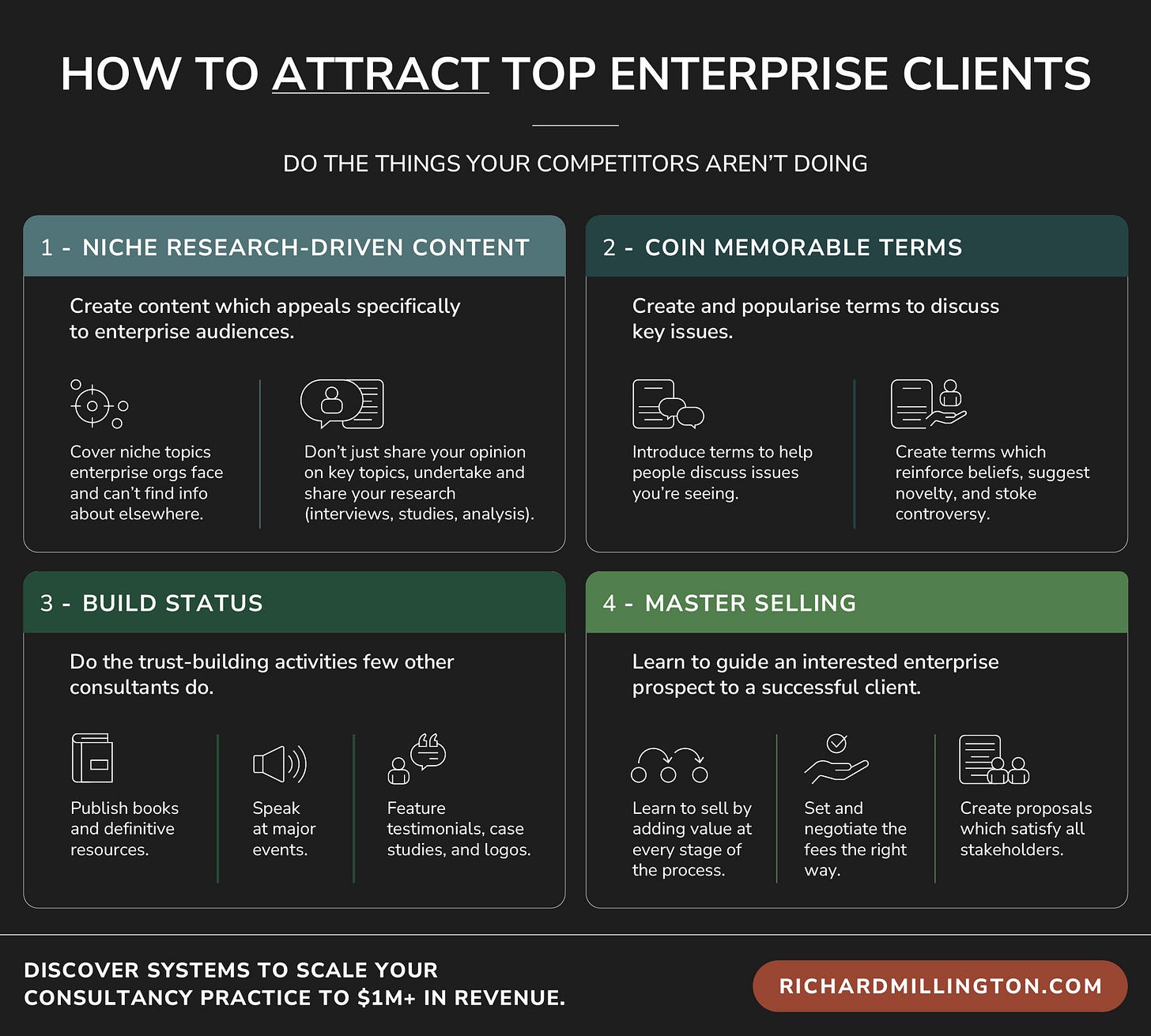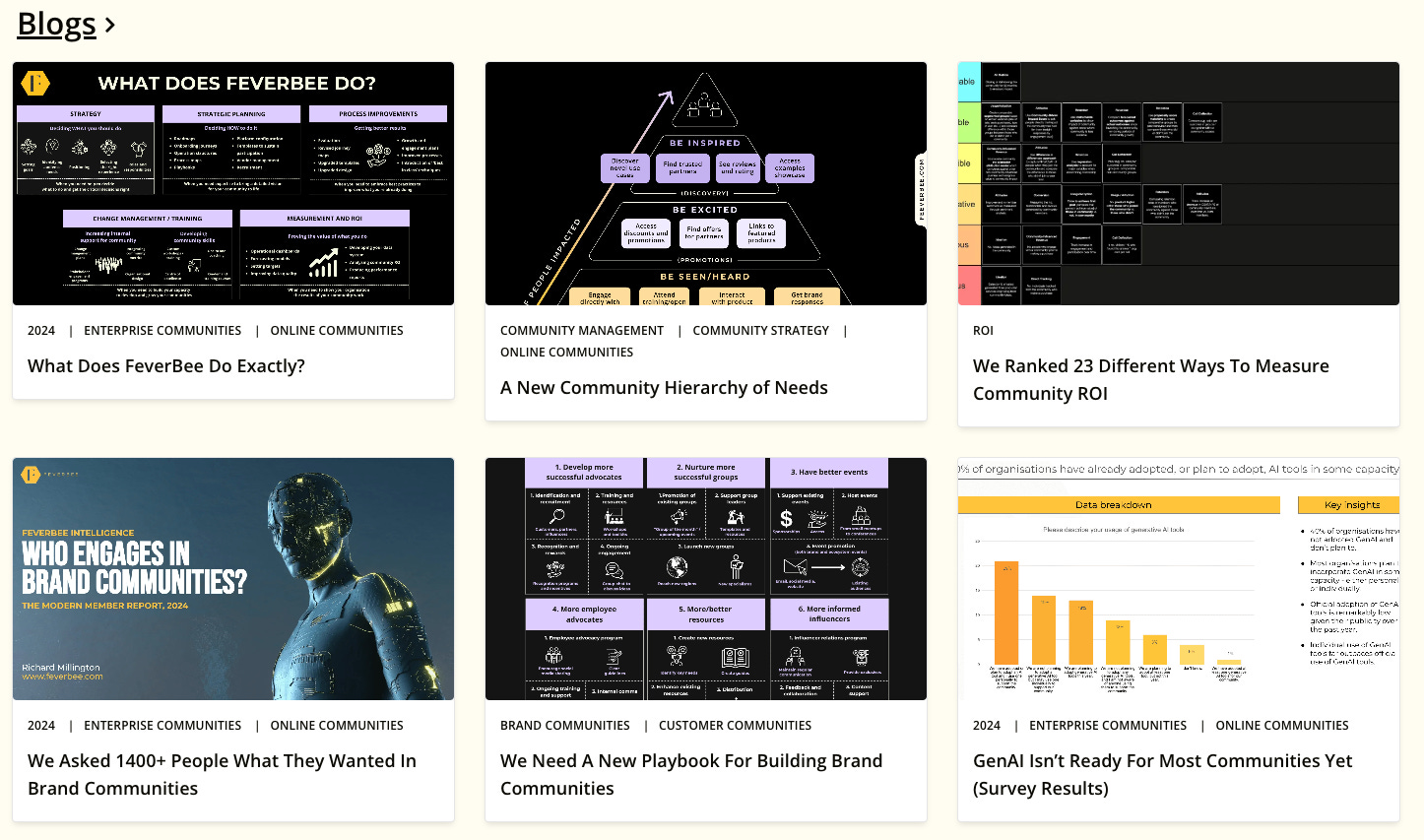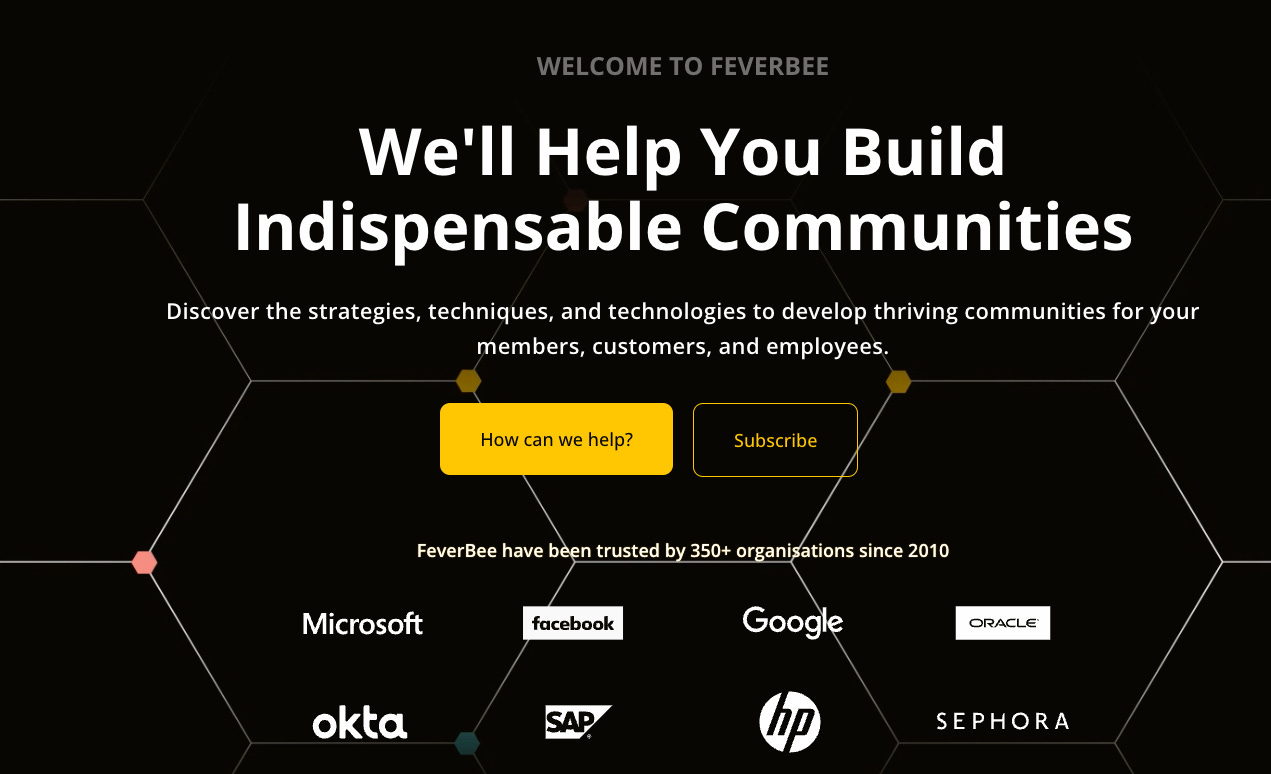The Somewhat Secret Things We Do To Attract Enterprise Clients
Attract enterprise clients by solving niche problems with research-driven content, catchy terms, and credible case studies. Focus on specificity and actionable insights to build trust and stand out.
Hi, I’m Richard Millington. Please subscribe to my newsletter to discover our systems for scaling your consultancy practice to $1m+ in revenue.
What Does FeverBee Do That Most Consultants Don’t?
Our roster of current/past clients is incredible. We have worked directly with Apple, Alphabet, Microsoft, Meta, HP, Intel, SAP, Oracle, the World Bank, Greenpeace, Audi, Atlassian, Sephora, Okta, the United Nations, the OECD, and many more (no pretend clients here)
Recently, Manuel asked how we attract and sign these kinds of firms as clients. My initial response is, “I don’t know; it just kind of happens.”
But it doesn’t ‘just happen.’ I suspect that’s because we’ve been doing what we’re doing for so long that it feels normal. It isn’t. There are things we’ve gotten into the habit of doing that are different and attract a steady pipeline of impressive enterprise clients that others don’t.
It could be that we entered the space early and built up a lead that was difficult for others to match. Over the past few years, I’ve seen many consultants launch a practice and struggle, while others have launched and quickly attracted a good base of enterprise clients. These consultants do things differently.
See: How We Attract The World’s Top Firms As Clients
Creating Very Specific Types Of Content
Create content targeted for the specific people you want to work with — which they can’t get anywhere else
We publish a lot.
I’ve published thousands of posts about building communities, one almost every working day for 12 years. That alone likely attracts more search traffic than most organisations. But I don’t think creating lots of content alone is a game-changer. The type of content we make (especially these days) differs from what I see other consultants create.
The brutal reality is that most content consultants publish is of low quality. It’s opinion-led, poorly targeted, patronising, generic twaddle which could have quickly been churned out by AI (the same is true with talks at conferences too).
This reflects a combination of laziness, a lack of expertise, and an inability to understand what people at enterprise brands really need.
Stop Publishing Opinion Posts, Start Undertaking Projects
We think of posts now less as posts and more as research projects.
We will investigate an important question and come up with an answer.
Here’s an example…
Problem: Incorrect Answers Filling Up Communities
We’re currently working on several articles, one of which is titled ‘What should brands do about old discussions in customer support communities?’
Many major brands have a customer support forum where people ask and answer each other’s questions. However, as products are updated, terms change, and features come and go, many old answers to questions no longer solve the problem—yet they will still be the first answer appearing in relevant searches.
This means visitors increasingly land on answers marked as correct but no longer work.
Imagine these communities filling up over time with thousands of incorrect answers. Solving that problem would be infuriating.
The Topic Matters
There’s a lot more depth to the problem, but the problem itself isn’t the point here. The point is the topic. Consider two things here:
Only major enterprise communities have this problem. The communities with thousands of outdated posts about products are usually large enterprise communities. It’s a relevant problem faced by the organisations we want to work with. It’s a problem we know many are struggling with.
There is almost no other information available to solve it. Look around if you like; virtually no one else shares solutions to this problem, and if there are, it’s unlikely our audience would have seen it.
Both of these combined create an excellent opportunity to undertake some research and create unique value for our audience - value which positions us as experts in the minds of the people we want to work with.
Our target audience faces a key problem that they can’t find a solution to elsewhere. I don’t know about you, but that sounds exactly like the gap consultants should fill.
Now, We Do The Research…
But we’re not just going to share our opinions about what people should do. While we’ve worked on this with a few clients, our data set isn’t large enough to share a best practice.
We will research the problem, contact a dozen or so people at major brands, learn what they’re doing to solve it, and publish the summary as a post, video, etc…
Aside: This means we’ve built stronger relationships with a dozen or so people who are then likely to share the finished article.
See: Become the top expert on a big, expensive problem.
Create Unique Value That Our Target Audience Can’t Get From Elsewhere
I don’t expect clients will hire us to solve this problem for them - it’s not a big enough problem for a consultancy project.
However, we’ve created unique value for our target audience, which they can’t get anywhere else. Our advice will be specific, research-based, and not vague, generic opinions. When you create unique, practice advice that solves pressing problems for particular people you want to work with - you stand out.
This post alone probably won’t land us a client. The problem itself isn’t big enough for a consulting project.
What this post will do is :
Attract the initial attention of people we want to work with. It will be shared internally and get us on the radar of key people.
Create and reinforce a perception of us. While others share fluffy, vague ideas, we share concrete advice that solves their real problems.
Be the tipping point. On rare occasions, it might be the tipping point which encourages brands to make contact finally.
A single post alone won’t attract a client, but once we have done this enough times (and we have), the specific people at the organisations we want to work with will begin to regard us as experts who can help them solve their unique problems.
When they get stuck and want help - who will they turn to?
This is what we do, which I see few others doing consistently.
Ignoring The Engagement Metrics - This Content Won’t Perform Well
I'd also like to point out how niche this problem is. The vast majority of people in our space don’t have this problem. However, if you’re running a community for the kinds of clients we want to work with - then you do.
This highlights a paradox. The content that appeals best to our clients is often so niche that it performs terribly according to most measures of engagement and popularity.
In short, you want to get narrow and create unique content that solves specific problems few others discuss.
The goal is to have a handful of raving fans who love your content because it speaks directly to them.
Naming Trends / Introducing Concepts
Make it easier to discuss an issue by coining an expression for it.
This was something I learned from Seth.
Making it easier to talk about a problem is a powerful way to position yourself in a crowded market.
Sometimes, everyone can see the same thing, but we cannot discuss the problem until it has a clear name.
We try to create catchy terms and names for the trends and issues we see. This is a handy way to introduce concepts. However, many ideas don’t catch on and simply become terms we use internally.
But sometimes, it spreads and attracts attention. After we used terms like "Community Architect”, “Community Everywhere," "Engagement Trap," etc.…, they became used much more frequently to define the problems and solutions we were seeing.
Generally, I test a term or concept in a LinkedIn post to see the response before publishing it to my mailing list or using it in talks. This lets me know what resonates and doesn’t, and I adjust accordingly.
Testing a few terms to see what resonates is a really good idea. If you want a term to spread, it must provoke an emotional feeling in the audience. It can’t be bland.
Generally a term will spread if it has an emotional component. In the above examples:
Community Architect - something community managers want to be in the future and thus are interested in liking/sharing this post.
Community Everywhere - controversial take - but again talks about the positive future of community.
Engagement Trap - a common frustration people face and need others to know about it.
You’re looking for expressions that reinforce an existing belief, are novel, frustrating, controversial, or surprise people.
The above steps (creating the right kind of content and coining expressions) help get you on the radar. Once you’re on the radar, you can do more things here.
I’ll cover each briefly.
Speaking At Events
Enterprise organisations are more likely to attend industry events than smaller organisations (it’s a budget thing). Speaking at an event is a great way to reinforce their perception of you.
For starters, someone else has validated you to put you on their stage. That helps a lot - especially if it’s the main stage at a significant event. Second, it presents an excellent opportunity to highlight your incredible value. But you have to give the right kind of talk in the right way.
I’ve covered this several times before, so I’ll link to the steps rather than repeat them here.
See: How To Get Coveted Speaking Slots At Major Industry Events
See: Delivering Talks Which Attract Clients
See: Thrilling Talks: Giving Client-Winning Talks At Major Events
Publishing Books
I was lucky to publish one of the first major books on this topic. Even today, I’m surprised at how well it did (and wish I’d spent much more time on the content and front cover).
Many people begin learning about a topic by buying books. Having my book appear high in the Amazon rankings helped me secure major clients. Having a book also helps when you’re promoting yourself.
Organisations sometimes buy books in bulk (as do events), and just publishing a book helps you connect with many of the people you want to communicate with (i.e. you can interview the people you want to work with for the book).
You can also use books as a giveaway to build your mailing list, attract people to connect with you, and gain additional benefits in the sales process.
You can learn more about how the book process helped below.
Logos, Case studies and Testimonials
Getting on the right people's radar is one thing; persuading prospective enterprise clients that you can be trusted to help them is another.
The biggest thing enterprise clients look for is whether you have worked with other enterprise clients. This is where logos (honest ones, not pretend ones) matter.
We’ve explored having dozens of logos on our site and just featuring a top few. It’s hard to test this, but it doesn’t really seem to matter. However, aesthetically, I suspect a few big logos are better than hundreds.
I included the number and our age because they highlight the stability and number of clients we’ve worked with.
We’re huge believers in proving what we do by sharing lots of video testimonials from our clients.
See: How We Present Testimonials In Proposals
The magic of this is that our clients are speaking for us. We also feature a number of case studies on our website (though we need to update this, to be honest). We want to have overwhelming social proof that our methods work.
I can’t stress enough that enterprise brands want to know that you’ve worked for enterprise brands.
Knowing How To Sell Also Helps
These are just some initial steps rather than a comprehensive list. You also need to know how to sell consultancy services, how to negotiate, be clear about how you add value, etc…
And, of course, you need to be terrific at writing proposals which can be approved by multiple stakeholders within the organisation.
(This is why consultants should complete Proposal Mastery before trying to sell at the enterprise level).
Summary
Let’s cover everything in this post:
Create Niche, Research-Driven Content. Focus on solving specific, big, and expensive problems your target audience faces by conducting research, interviewing experts, and publishing actionable insights.
Coin and Test Catchy Terms. Develop terms that emotionally resonate with your audience to define trends, problems, or solutions, and test their effectiveness on platforms like LinkedIn.
Speak at Industry Events. Secure speaking slots at major events to build credibility and reinforce your value through third-party validation. Deliver engaging talks that address pressing enterprise problems and highlight your expertise.
Publish High-Value Books. Write books that tackle key challenges faced by your audience, using them as tools to establish authority, generate leads, and build relationships.
Leverage Logos, Testimonials, and Case Studies. Showcase your enterprise experience with authentic client logos, testimonials, and case studies that highlight measurable success.
Ignore Engagement Metrics, Focus on Specificity. Target niche problems that matter most to your audience, even if the content doesn’t perform well by traditional metrics.
Master Selling and Proposal Writing
Refine your skills in selling, negotiating, and crafting compelling proposals that resonate with enterprise clients.
Good luck!
p.s. If you want to get better at writing proposals, sign up for our Proposal Mastery course.






Excellent post with a novel idea for independent or small consulting firms to gain traction with enterprise clients. These techniques help build the top of the funnel. The key objectives are to build niche expertise, authority and delivery credibility. But my experience corresponds with yours, that business development and sales capabilities are crucial to winning the business. Some of this depends on the target size of your engagements. I have seen it work for lots of different consulting domains. An old associate of mine built up a 10 person firm in Regina that had clients around the world based on leveraging his expertise and knowledge in one small but occasionally critical MS Dynamics 365. He also used the blogging and research approach
I have employed a related technique to identify and generate expertise and authority in any new trending topic area.
Great post, Richard. The part about introducing new names or concepts to label specific issues is really important to anchor your audience -- whether it's clients, your team, followers, etc. I shared a similar sentiment -- https://groupproject.substack.com/p/naming-a-thing-is-powerful